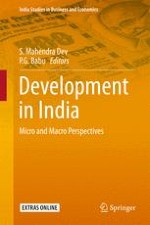2016 | OriginalPaper | Buchkapitel
7. Agriculture and Structural Transformation 1960–2040: Implications for Double-Digit Inclusive Growth
verfasst von : Kirit S. Parikh, Hans P. Binswanger-Mkhize, Probal P. Ghosh
Erschienen in: Development in India
Verlag: Springer India
Aktivieren Sie unsere intelligente Suche, um passende Fachinhalte oder Patente zu finden.
Wählen Sie Textabschnitte aus um mit Künstlicher Intelligenz passenden Patente zu finden. powered by
Markieren Sie Textabschnitte, um KI-gestützt weitere passende Inhalte zu finden. powered by
